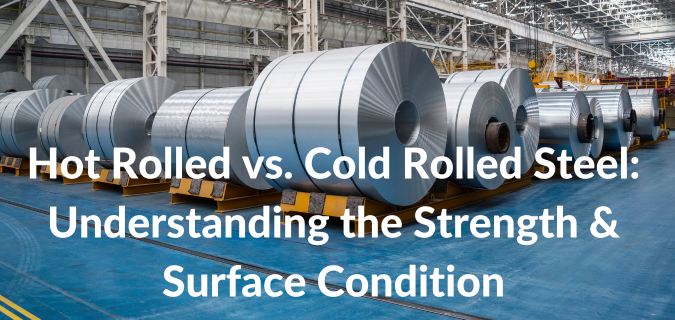
It’s easy to talk about how important steel is to our world. It’s used to build bridges and skyscrapers, cutlery and cookware, furniture, auto parts, and so much more. If we want to get especially self-aware, steel is used to make the very machines that process steel. Steel’s versatility is clear, but there is still much to be understood about how it is processed. Specifically, what is the difference between hot rolled steel and cold rolled steel, and why would one process be more suited than the other for certain applications?
Hot Rolled Steel Process
Developing hot rolled (HR) steel begins with heating steel slabs to an extremely high temperature, above their recrystallization point, to soften the steel. From there, the softened steel is passed between powerful rollers to thin and shape the steel into its desired thickness. The HR steel process is fast and efficient, which makes HR steel a cost-effective option.
Hot Rolled Steel Properties
Once the hot rolled steel process is complete, you’ll find HR steel to have:
- Strength & Ductility: HR steel retains good strength and ductility, making it ideal for applications requiring bending or shaping.
- Formability: Not only can HR steel be formed to the desired thickness and shape during HR steel processing, but it can also be heated and re-formed as needed.
- A Rough Surface: Due to the high processing temperatures, HR steel has a mill scale (oxide layer) on its surface and a rougher finish. It may require additional treatment for aesthetics if desired or needed.
- Dimensional Variation: As a result of cooling following the rolling process, individual HR steel final products can vary in shape and dimension from batch to batch.
Cold Rolled Steel Process
The cold rolled (CR) steel process begins as HR steel and then goes through further processing. Once cooled to room temperature, the steel is again passed through rollers, this time with significant pressure. This helps achieve tighter tolerances and a smoother finish.
Cold Rolled Steel Properties
With the extra processing CR steel goes through, you’ll find cold rolled steel to have:
- High Strength & Hardness: Cold working strengthens the steel’s crystal structure, making it harder and stronger than HR steel.
- Superior Surface Finish: CR steel boasts a smooth, shiny surface, ideal for applications requiring paint or a polished look.
- Tight Tolerances: Cold rolling delivers more precise dimensions compared to HR steel.
- Work Hardening: The cold working process can introduce internal stresses in the steel. To improve its formability, CR steel may undergo annealing, a heat treatment that softens the material.
Hot Rolled vs. Cold Rolled Steel: Choosing Between HR and CR Steel
Certain applications are better suited for hot rolled steel and others for cold rolled steel. There are some general guidelines to follow, but it’s also helpful to discuss with a steel manufacturing expert like Capital Steel & Wire to determine exactly what type of steel is best for your application. This expertise is particularly important when considering hot rolled steel grades and cold rolled steel grades, which can look confusing and intimidating at first.
In general, HR steel is ideal for applications that prioritize affordability and formability, as well as hidden structural elements (supports, fasteners, agricultural implements, etc.). When used as hidden structural elements, HR steel typically doesn’t need to be treated for aesthetics as its rough edges won’t be seen, all the while its strength and ductility give you the support you need in your application.
For projects requiring high strength, smooth finishes and tight tolerances, CR steel is the way to go. Automotive parts, appliances, oil, gas and energy parts, and more benefit from the precise dimensions and aesthetically pleasing smooth finish of CR steel.
Choose HR or CR Steel from Capital Steel
By understanding HR vs. CR steel, you can make informed decisions when selecting the best material for your next project. Capital Steel & Wire is here to answer your questions and help you figure out exactly what is the best material for your next project. Contact us today to find the perfect steel solution.





